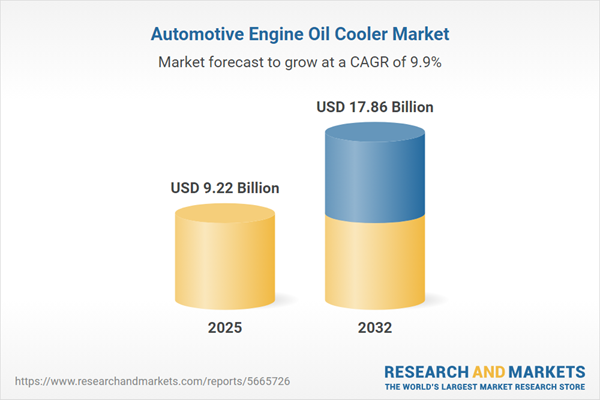Speak directly to the analyst to clarify any post sales queries you may have.
Senior automotive executives are navigating a rapidly transforming landscape as the automotive engine oil cooler market adjusts to shifting global regulations, intensified competition, and accelerated technology adoption. Informed, data-backed decision-making is essential for organizations striving to remain resilient and competitive.
Market Snapshot: Automotive Engine Oil Cooler Market Size and Growth
The automotive engine oil cooler market is projected to advance from USD 8.40 billion in 2024 to USD 9.22 billion in 2025, ultimately reaching USD 17.86 billion by 2032. This significant growth is propelled by increasing demand for advanced thermal management solutions, the integration of next-generation powertrains, and heightened international competition. Automotive Original Equipment Manufacturers (OEMs) are responding with innovative production techniques and supply chain optimization, strengthening the market’s adaptability to regulatory and technology developments. The engine oil cooler sector is positioned at a strategic convergence of technical innovation and evolving global policy.
Scope & Segmentation: Strategic Areas for Decision-Making
This comprehensive report delivers actionable segmentation insights, supporting leaders as they develop strategies and allocate resources for optimum market impact. Each segment represents essential considerations for operational planning, regulatory compliance, and future investments:
- Application: Evaluates thermal management needs across commercial vehicles, passenger cars, electric and hybrid vehicles, off-highway equipment, and industrial machinery, each facing unique challenges in optimizing efficiency and regulatory alignment.
- Product Type: Details the deployment of air-cooled and water-cooled systems, modular setups, and smart controls, spotlighting their role in supporting diverse powertrain architectures and dynamic vehicle standards.
- Distribution Channel: Analyzes OEM, aftermarket, direct-to-consumer, and e-commerce models, illustrating changes in procurement strategies and the impact on market accessibility and supply chain speed.
- Material: Assesses the adoption of aluminum, copper brass, composites, and nanocoatings, focusing on durability, lifecycle cost, and how these choices advance environmental and sustainability targets.
- Fuel Type: Addresses compatibility with diesel, gasoline, alternative fuel, and hydrogen-powered systems, underscoring implications for global emissions compliance and operational requirements.
- Region: Highlights market opportunities and regulatory challenges in the Americas, Europe, Middle East & Africa, and Asia-Pacific, reflecting distinctions in infrastructure, consumer demands, and compliance frameworks.
- Key Players: Summarizes how leading firms—including Denso Corporation, Marelli Holdings, Valeo SA, BorgWarner, Dana, Hanon Systems, and Modine Manufacturing—leverage alliances and technology to drive competitive differentiation.
This segmentation framework is designed to empower automotive leaders to make strategic, well-informed choices and align operational goals with diverse market and regulatory dynamics.
Key Takeaways for Senior Decision-Makers
- Accelerated deployment of modular and intelligent cooling technologies is streamlining operations for OEMs and automotive fleets, fostering increased digitization across the industry.
- Innovative use of composites and nanocoatings is promoting eco-conscious manufacturing and supporting stricter compliance with new environmental standards.
- Growth in direct-to-consumer and e-commerce channels is enhancing procurement agility, demanding rapid adaptation throughout supply networks.
- The shift toward electrified drivetrains is reshaping design and engineering priorities, requiring manufacturers to balance adaptability with technical expertise in new power systems.
- Regional diversity in policy frameworks continues to create complexity, underscoring an urgent need for flexible, forward-thinking supply chain models.
- Collaboration between major OEMs and technology innovators is accelerating integration of advanced thermal management solutions and responsiveness to regulatory updates.
Tariff Impact and Supply Chain Adaptation
Recent U.S. tariff revisions are prompting automotive engine oil cooler manufacturers to reexamine sourcing and production footprints. Emphasis on regionalized manufacturing, continuous workforce upskilling, and building resilient supplier relations enables companies to address regulatory changes while minimizing operational disruptions. Adoption of adaptive supply frameworks further assists in navigating cross-border compliance and volatility.
Methodology & Data Sources
This analysis is based on a systematic blend of quantitative and qualitative research methods, utilizing peer-reviewed industry standards to maximize accuracy. The approach prioritizes actionable, current insights for senior decision-makers in the automotive engine oil cooler sector.
Why This Report Matters for Automotive Engine Oil Cooler Market Leaders
- Provides relevant, actionable intelligence to inform strategic direction and anticipate shifts in technology and regulation.
- Strengthens supply chain resilience through scenario-based planning and tailored risk assessments that address market-specific challenges.
- Equips technical teams with guidance on emerging materials and global manufacturing practices, aiding in informed capital allocation and efficiency improvements.
Conclusion
This report delivers advanced segmentation, validated market insights, and practical frameworks, empowering automotive sector decision-makers to confront evolving industry demands and secure sustainable organizational growth.
Additional Product Information:
- Purchase of this report includes 1 year online access with quarterly updates.
- This report can be updated on request. Please contact our Customer Experience team using the Ask a Question widget on our website.
Table of Contents
3. Executive Summary
4. Market Overview
7. Cumulative Impact of Artificial Intelligence 2025
Companies Mentioned
The companies profiled in this Automotive Engine Oil Cooler market report include:- Denso Corporation
- Marelli Holdings Co., Ltd.
- Valeo SA
- BorgWarner Inc.
- Dana Incorporated
- Hanon Systems Co., Ltd.
- Modine Manufacturing Company
Table Information
| Report Attribute | Details |
|---|---|
| No. of Pages | 181 |
| Published | November 2025 |
| Forecast Period | 2025 - 2032 |
| Estimated Market Value ( USD | $ 9.22 Billion |
| Forecasted Market Value ( USD | $ 17.86 Billion |
| Compound Annual Growth Rate | 9.8% |
| Regions Covered | Global |
| No. of Companies Mentioned | 8 |









